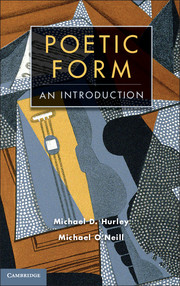Chapter 3 - The Sonnet
Published online by Cambridge University Press: 05 November 2012
Summary
In truth the prison, into which we doom
Ourselves, no prison is …
Wordsworth (‘Nuns Fret Not at Their Convent’s Narrow Room’)Established in thirteenth-century Sicily, the sonnet is the most enduring, the most widely used and the most immediately recognisable of all ‘closed’ poetic forms. The early Italian sonneteers – Guinicelli, Cavalcanti, Dante and, of course, Petrarch – determined its verse structure: fourteen lines, rhymed abba; abba; cde; cde (the last six lines may alternatively be rhymed cdc; dcd, or any similar combination of two or three non-consecutive but interlocking rhymes). These sonnets typically progress in two parts: a thought or problem is proposed in the first part and addressed, contradicted or otherwise resolved in the second. The ‘turn’ towards resolution, known as the volta, occurs at the point where the rhyme scheme changes; the poem’s argument hinges, in other words, between the first eight lines (the ‘octave’) and its final six (the ‘sestet’).
Subsequent evolution of this ‘Italian’ form has tended to be described with irrational nostalgia. The ‘law’ of the sonnet’s structure is said to have ‘written itself explicitly and finally’; its ‘standards’ are thought ‘irremovable’. Such purism is prosodically naive. However well the ‘Italian’ metre and rhyme patterns suited the Italian tongue, different languages afford different formal possibilities. When the sonnet was first adopted into England in the early sixteenth century, the Italian hendecasyllabic metre had first to be adapted: it was naturalised into the English iambic pentameter (similarly, when the sonnet was translated into French at the same time it was naturalised into alexandrines). That metrical mutation goes unremarked upon because it is generally thought unremarkable; comment and disapproval is reserved for the way English poets refashioned the Italian rhyme scheme, by increasing the number of end rhymes from four or five to seven. But in the case of its rhyme as in its metre, the literary structure of the English sonnet expresses something about the linguistic structure of the English language. Because there are more rhyming possibilities in Italian than in English, and Italian rhymes may also be employed less intrusively (in that they are all feminine), English poets wishing to enjoy the same flexibility in their sonneteering reduced the burden of rhymes they were required to repeat.
- Type
- Chapter
- Information
- Poetic Form , pp. 76 - 99Publisher: Cambridge University PressPrint publication year: 2012

